by Nathan Leung
It has been over a month since I arrived in Bogotá for my internship at Avocats Sans Frontières Canada (ASFC), and although there were some bumps in settling down, adapting to life in Colombia has been extremely rewarding. I will dedicate the first section of this blog post to my work and apartment situation, and the second half to observations and recommendations about living in Bogotá.
During the first two weeks, I found it difficult forming a routine as work in person is still only two days per week as per COVID restrictions in Colombia. I did not see my colleagues often, but they were quick to respond to any concerns I had on Whatsapp and were extremely happy to help. I have learned that it is important to be patient as I started to feel more comfortable when I finished furnishing my apartment and received research work about Colombia’s armed conflict.
Another challenge I had during the first few weeks was my apartment. The owner and security guard were friendly and accommodating, but the building was located in an area with abandoned buildings. Many people cautioned me against walking by myself as they told me they had seen people selling drugs on the street.
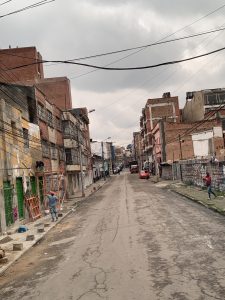
I eventually moved to Chapinero Alto, a hilly and upscale neighbourhood that was worlds apart from my initial residence. Nevertheless, I enjoyed having the experience of living in a not-so-safe neighbourhood vs a pristine one.
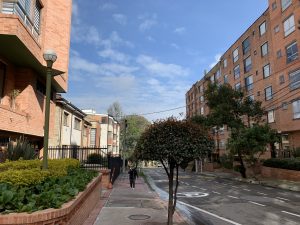
An important lesson I learned at work is that not all issues can get the attention they deserve. When I first learned about ASF’s project on human trafficking, titled “No Más Trata” (No More Human Trafficking), I was interested by how Venezuelan migrants were affected by this issue. However, my colleague reminded me that the project is mainly focused on women, children, and the LGBTQ community, and the focus on migrants would be out of scope.
Colombia’s armed conflict is also complex from the multiple actors that are involved against the government, and the government itself that has also perpetrated crimes against humanity. Reading about the armed conflict to prepare for my research tasks has reminded me that often there is no black and white for who is “right” and who is “wrong”.

_____________________________________________________________________
Bogotá can be a city of contrasts. The weather is infamously unpredictable, with it being warm and sunny one moment and the next, chilly and rainy. The pollution from cars is also variable depending on whether you’re on a major city road or a smaller residential one. It is also possible to get lunch for $11 000 COP (around $3.70 CAD), complete with soup and a drink, and the same menu item at a fancier restaurant for almost triple the price at $33 000 COP (around $11 CAD).
Traffic jams are common in Bogotá, being a city of around eleven million people yet not having a metro system. I have learned to avoid travelling during the peak hours when possible: 7am to 11am in the mornings, and from 5 to 8pm in the evenings. Transmilenio, the city’s bus rapid transit system, is often filled to the brim from my glances at it out from the taxi window. I have been told that Transmilenio is not quite safe to ride and that robberies are not uncommon. I recommend having multiple taxi apps such as Cabify, Taxis Libres, and Didi, as there may not always be drivers on one app.

Making a cédula de extranjería (foreigner’s ID card) is useful for daily transactions and identification in Colombia, though an appointment is required in advance with Migración Colombia. You are also required to know your blood type as it is printed on the card. With a cédula, there is no need to carry your passport outside, and it enables you to register for services such as phone plans or points at the local supermarket and restaurants.
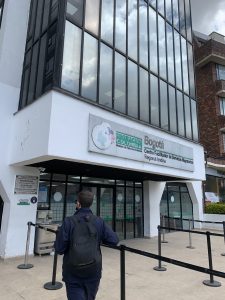
Bogotá does not disappoint for adventurous eaters. Tropical fruits such as maracuyá (passion fruit), lulo, papaya, guanabaná (soursop), and granadilla can be easily found.
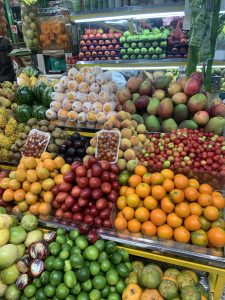
Bogotá is known for soupy and hot foods, due to it having a relatively cool climate in the Andes Mountains. Ajiaco, chocolate santafereño, changua, caldo de costilla are among some of its delicacies. However, it is good to be cautious with what you eat as I got food poisoning that set me back for a week. I have heard that as Bogotá is not on the coast, seafood is not as fresh, and it is always good to check that the restaurant is reputable.
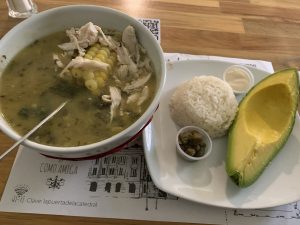
Overall, people in Bogotá are generally friendly and willing to help even though the city can be chaotic, polluted, and dangerous at times. I have come to appreciate the city’s lifestyle and am excited to become even more familiar with the city by the end of my internship. Having read multiple books at the start of my internship, I am looking forward to putting it to use in my research work for the next two months. No matter what happens, I will remember to stay tranquilo (“calm”, “no problem”) as Colombians say and to view this city through their lens.
